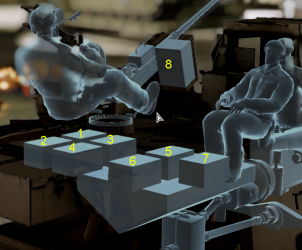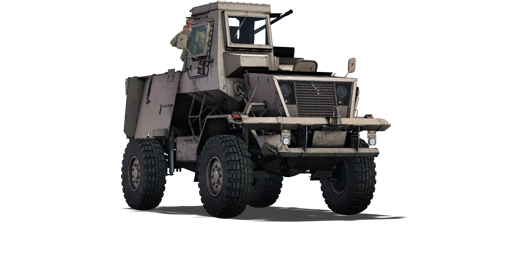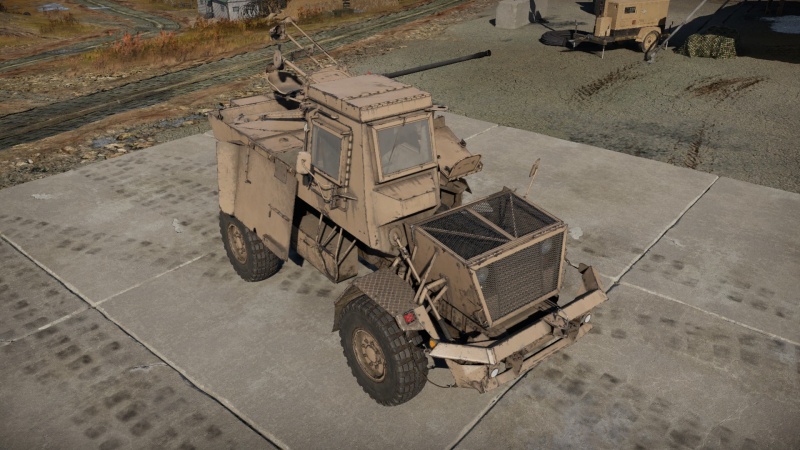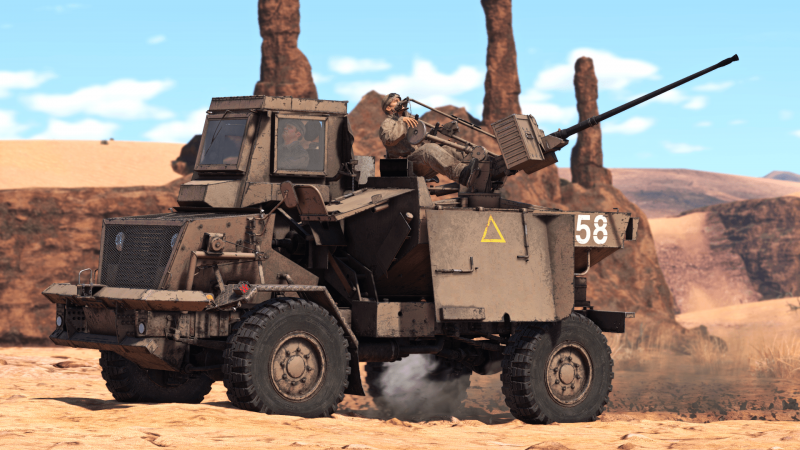Difference between revisions of "Ystervark"
(→Pros and cons) (Tag: Visual edit) |
Colok76286 (talk | contribs) (Edits) |
||
| Line 144: | Line 144: | ||
* No armour protection, making it highly vulnerable to MG bullets, shrapnel, and even ramming from tanks and aircraft | * No armour protection, making it highly vulnerable to MG bullets, shrapnel, and even ramming from tanks and aircraft | ||
* Is wheeled, meaning its mobility will be significantly worsened on bad road conditions | * Is wheeled, meaning its mobility will be significantly worsened on bad road conditions | ||
| − | |||
* Gunsight is positioned far above the gun, which can be awkward to aim in simulator | * Gunsight is positioned far above the gun, which can be awkward to aim in simulator | ||
* Complex appearance can make it hard to place bushes, decorators, and decals | * Complex appearance can make it hard to place bushes, decorators, and decals | ||
Latest revision as of 17:30, 22 July 2024
Contents
Description
The Ystervark is a self-propelled anti-aircraft (SPAA) vehicle operated by the South African Defence Force (SADF). Taking its name from the South African cape porcupine, an animal with a powerful physique protected by an astonishing array of spines to defend itself against predatory animals, a vehicle named after this species should represent those attributes. The Ystervark SPAA is a solid and robust vehicle designed to withstand the harsh South African environment. The Ystervark SPAA was developed in the 1980s in response to a mobile and mine-protected anti-air platform request. It is based on another project, Project Sireb, which produced three mine-resistant vehicles as potential replacements for the Buffel armoured personal carrier (APC). One of the three prototypes, nicknamed the "Bulldog," would serve as the foundation for the Ystervark SPAA by removing the passenger tub and replacing it with the weapons platform.
Introduced in Update "Ground Breaking", the Ystervark is exceptional at anti-air roles in the right hands. Since the crew is all exposed without armour protection, it is critical to always remain hidden and undetected when driving. This vehicle can easily bring down any aircraft during engagements thanks to its fast-firing and accurate 20 mm GAI C01 autocannon. As the ammunition is limited, it is critical to fire in short bursts. It also has some limited anti-tank capability owing to its high-velocity armour-piercing (HVAP) ammunition, although it is not recommended to use such a vehicle to engage enemy ground targets unless absolutely essential.
General info
Survivability and armour
As is the case with most truck or flatbed-based SPAA vehicles, the entire crew is not protected by any meaningful armour or cover. The commander and gunner sit unprotected in the open, and the driver is protected by thin armour and bulletproof glass at best. The ballistic glass can, in exceptional cases or at extreme impact angles, stop rifle calibre fire or even 20 mm grenades and protect the driver, but the only lightly armoured cabin virtually nullifies any protective effect of the bulletproof glass.
The survivability of this vehicle lies in its compact size and speed, the Ystervark will endure at the hands of a shrewd and map-savvy player. The vehicle can hole up in smaller spaces or bury itself comfortably in thickets and bush. It can find itself nestled amongst burning wrecks or even climb into some building ruins. it also presents a small and hard to hit target when rushing away at its top speed to elude danger.
Armour type:
- Structural steel (chassis)
- Rolled homogeneous armour (cabin, truck bed, hood)
- Bulletproof glass (windscreen)
- Wheel (tires)
| Armour | Front (Slope angle) | Sides | Rear | Roof |
|---|---|---|---|---|
| Chassis | 2-5 mm (12-82°) Grille & Bumpers | 4 mm Top 4 mm (60°) Bottom 5 mm Chassis |
4 mm (19°) | |
| Drivers cabin | 4 mm (12°) Cabin 60 mm (12°) Windshield |
4 mm (0-7°) Cabin 60 mm (0-7°) Windshield |
2 mm (2°) |
Notes:
- Wheels are 10 mm thick, tracks are 30 mm thick, and torsion bars are 60 mm thick.
- Vents and mudguards are 2 mm thick.
Mobility
| Game Mode | Max Speed (km/h) | Weight (tons) | Engine power (horsepower) | Power-to-weight ratio (hp/ton) | |||
|---|---|---|---|---|---|---|---|
| Forward | Reverse | Stock | Upgraded | Stock | Upgraded | ||
| Arcade | 98 | 15 | 6 | 176 | 237 | 29.33 | 39.5 |
| Realistic | 90 | 13 | 110 | 124 | 18.33 | 20.67 | |
With a top speed of 89 Km/h, the Ystervark is a very fast vehicle. Compared to most other vehicles its weight of merely 6 metric tonnes renders it incredibly agile, able to clamber readily up steep slopes and turn tight corners without the loss of much speed. However, this comes with one downside in the form of the reverse speed; the Ystervark has a reverse speed of only -13 Km/h meaning that getting into a position is easy, but not always as easy to escape it when things turn south if accelerating forward is not an option.
The suspension on the Ystervark is superb, maintaining a very stable base on the vehicle when performing manoeuvres such as turns on hills or crossing uneven terrain. The 20 mm gun is very much operable when driving at speed owing to the performance of this suspension even while stock.
As with all wheeled vehicles, beware such terrain types as: Snow, muddy ground and deeper sand. The Ystervark suffers greatly when it is bogged in these terrain types and loses its one greatest asset: its agility.
Modifications and economy
Armaments
Main armament
| 20 mm GAI C01 | Turret rotation speed (°/s) | Reloading rate (seconds) | ||||||||||||
|---|---|---|---|---|---|---|---|---|---|---|---|---|---|---|
| Mode | Capacity (Belt) | Fire rate | Vertical | Horizontal | Stabilizer | Stock | Upgraded | Full | Expert | Aced | Stock | Full | Expert | Aced |
| Arcade | 600 (75) | 996 | -7°/+83° | ±180° | N/A | 39.6 | 54.8 | 66.6 | 73.6 | 78.4 | 9.10 | 8.05 | 7.42 | 7.00 |
| Realistic | 26.8 | 31.5 | 38.3 | 42.3 | 45.0 | |||||||||
Ammunition
- Default: HVAP-T · HEFI-T
- M594: HEFI-T · HEFI-T · HVAP-T
- M601: HVAP-T · HVAP-T · HEFI-T
| Penetration statistics | |||||||
|---|---|---|---|---|---|---|---|
| Ammunition | Penetration @ 0° Angle of Attack (mm) | ||||||
| 10 m | 100 m | 500 m | 1,000 m | 1,500 m | 2,000 m | ||
| HVAP-T | 57 | 52 | 37 | 24 | 15 | 10 | |
| HEI-T* | 6 | 6 | 4 | 3 | 2 | 2 | |
| Shell details | ||||||||||||
|---|---|---|---|---|---|---|---|---|---|---|---|---|
| Ammunition | Velocity (m/s) |
Projectile mass (kg) |
Fuse delay (m) |
Fuse sensitivity (mm) |
Explosive mass (TNT equivalent) (g) |
Ricochet | ||||||
| 0% | 50% | 100% | ||||||||||
| HVAP-T | 1,100 | 0.11 | - | - | - | 66° | 70° | 72° | ||||
| HEI-T* | 1,054 | 0.12 | 0.1 | 0.1 | 27.2 | - | - | - | ||||
Ammo racks

| Full ammo |
Ammo type |
1st rack empty |
2nd rack empty |
3rd rack empty |
4th rack empty |
|---|---|---|---|---|---|
| 8 600 |
Magazines Rounds |
7 (+1) 525 (+75) |
6 (+2) 450 (+150) |
5 (+3) 375 (+225) |
4 (+4) 300 (+300) |
| 5th rack empty |
6th rack empty |
7th rack empty |
8th rack empty |
Visual discrepancy |
|
| 3 (+5) 225 (+375) |
2 (+6) 150 (+450) |
1 (+7) 75 (+525) |
0 (+8) 0 (+600) |
No |
Note:
- Ammunition is divided into 8 magazines of 75 rounds.
Usage in battles
The Ystervark can be an exceptional ambush predator in the right hands. Whether your prey of choice is the flanks of unsuspecting tanks or aircraft buzzing overhead.
Staying low and unseen with a patient mindset when driving the Ystervark can be greatly rewarding to the player. With a 75 round fast firing belt of 20 mm ammunition, the player can use their small size to lurk where aircraft will complacently fly low and not traditionally avoid (Like the opposing team's spawn, where most SPAA prefer to seat themselves.). With this in mind, the gun has the speed and accuracy to seize on opportunities created by the stealthy approach, often snapshot bursts are enough to bring an aircraft down with enough practice.
The same tactics can be employed on vehicles, however bear in mind the 57 mm maximum penetration of the HVAP-T shells is the best the vehicle can get, further modifications from stock only change the belt composition. While this is sufficient for most light and medium tanks the Ystervark will encounter at its BR in ground realistic, it can also encounter heavy tanks such as the M6A1 or the KV-85 in a full uptier. Neither of which the 20 mm HVAP-T can penetrate from the side.
When fighting aircraft such as Strike Fighters, it is advisable to conserve ammunition. 75 rounds is sufficient, but the fast firing rate of the 20 mm GAI C01 cannon can burn through that entire belt in just under five seconds (around 4.8 seconds during testing). At a reload time of 7 seconds with an untrained crew, this can be enough time for a fighter to strafe the defenceless vehicle. Due to the non-existent armour of the Ystervark, this will in most cases end in the destruction of the vehicle.
Pros and cons
Pros:
- Fast rate of fire allows it to easily score hits with a burst on an aircraft's flight path
- Small profile makes it very easy to conceal itself
- High top speed of 90 km/h means great agility
- Lack of armour means conventional cannons will struggle to knock it out with a single shot if poorly aimed
- 75-round belt allows it to confidently engage targets without worrying too much about reloading
Cons:
- The driving compartment can obstruct the autocannon's gun depression, which might be sometimes fatal
- No armour protection, making it highly vulnerable to MG bullets, shrapnel, and even ramming from tanks and aircraft
- Is wheeled, meaning its mobility will be significantly worsened on bad road conditions
- Gunsight is positioned far above the gun, which can be awkward to aim in simulator
- Complex appearance can make it hard to place bushes, decorators, and decals
History
Up to the early 1980s, the SADF anti-air regiments were reliant on towed equipment. However, as the military doctrine shifted towards mobile warfare, the need for a self-propelled anti-air gun unit became clear. As a result, South African engineers began working on a respective design, which had to be rugged enough to withstand the harsh South African terrain and threat of landmines, yet light enough to ensure a high level of mobility.
In 1981, three prototypes of an MRAP vehicle were evaluated as a possible replacement for the Buffel APC. None of these replaced the Buffel, but one of these prototypes, known as the "Bulldog", formed the basis for the Ystervark. The superstructure was removed, and an anti-aircraft gun was placed on the chassis. Entering service almost immediately, the Ystervark was used to accompany South African mechanized battalions and protect strategic assets, such as air bases in the territory of South-West Africa. It was first tested in 1984 during the division-scale exercise Operation Thunder Chariot.
However, the Ystervarks didn't have to wait long for their first combat deployment. Taking part in several operations in the ongoing South African Border War from 1986 on, they were used to great success as deterrents to low-flying Angolan attack aircraft and helicopters, even downing several Angolan MiGs in 1986 and 1987. After the conclusion of the Border War in 1989, the Ystervark was gradually being phased out of service in 1991 and replaced by the Bosvark, an SPAAG based on the SAMIL 100 Kwêvoël mine-protected armoured truck. Officially, the Ystervark was withdrawn from active service in 1997 after more than 70 units were produced.
- From Devblog
Media
- Skins
See also
Links to the articles on the War Thunder Wiki that you think will be useful for the reader, for example:
- reference to the series of the vehicles;
- links to approximate analogues of other nations and research trees.
External links
| Britain anti-aircraft vehicles | |
|---|---|
| Crusader AA | Crusader AA Mk I · Crusader AA Mk II |
| Wheeled | Staghound AA · AEC AA |
| Radar SPAAG | Chieftain Marksman |
| Missile SPAA | Stormer AD · Stormer HVM |
| Other | Light AA Mk I · Falcon |
| Canada | Skink · ADATS (M113) |
| South Africa | Ystervark · Bosvark · ZA-35 |






